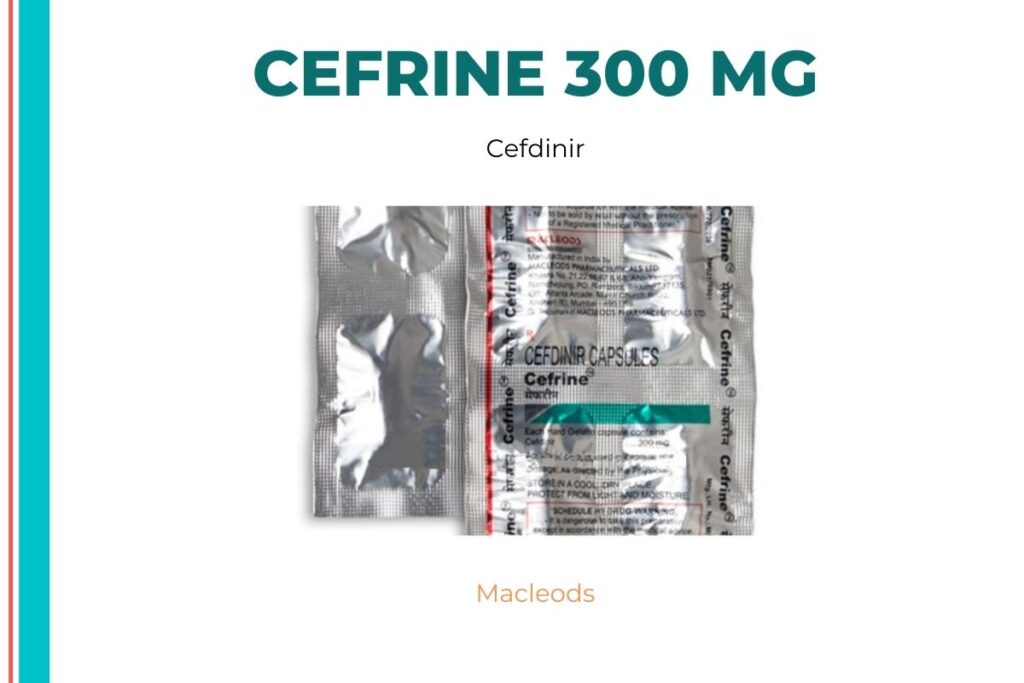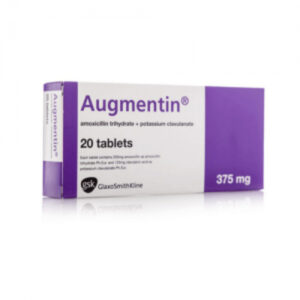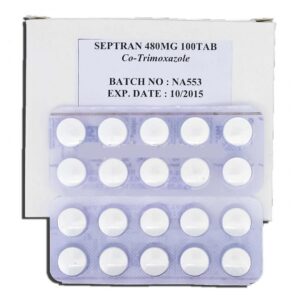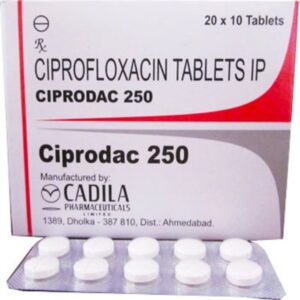Cefrine 300 mg
Cefrine 300 mg is an antibiotic that can be used to treat bacterial infections of the urinary system, bones and joints, heart, lungs, brain, chest, ears, skin, and soft tissues. A bacterial infection is a disease in which dangerous bacteria multiply and cause illness in the body. It has the ability to infect any region of the body and spread swiftly. Cefrine 300 mg is ineffective against viral illnesses such as the flu or the common cold.
Cefrine 300 mg includes the cephalosporin antibiotic ‘Cefdinir,’ which acts by interfering with the production of the bacterial cell wall (a protective coating) that is required for survival. As a result, the bacterial cell wall is damaged, and the organism is killed.
Follow your doctor’s instructions when using Cefrine 300 mg. Cefrine 300 mg should be used for as long as your doctor has recommended it based on your medical condition. Diarrhoea, nausea, stomach discomfort, vomiting, rash, headache, or vaginal itching or discharge are all possible side effects. The majority of Cefrine 300 mg side effects do not require medical care and fade away with time. Please visit your doctor if the adverse effects continue or worsen.
Please inform your doctor if you are allergic to Cefdinir , cephalosporin antibiotics, or any other medications. Before using Cefdinir , tell your doctor if you are pregnant or nursing. Cefrine 300 mg is not suggested for newborns under the age of six months since its safety and effectiveness have not been proven. Cefdinir may produce dizziness, so drive only if you are aware. It is recommended that you wait at least 2 hours between using Cefdinir and consuming antacids, magnesium, iron supplements, or multivitamins containing iron. These may impair the body’s absorption of Cefrine 300 mg.
Bacterial infections are treated with Cefrine 300 mg.

Medicinal Advantages
Cefdinir is a cephalosporin antibiotic that is used to treat a variety of bacterial infections. Cefdinir is a broad-spectrum antibiotic that kills gram-negative and gram-positive bacteria that grow aerobically (with oxygen) and anaerobically (without oxygen). It prevents the bacterial cell wall (a protective coating) from forming, which is required for life. As a result, the bacterial cell wall is damaged, and the organism is killed.
Use Instructions
As directed by your doctor, use Cefdinir with or without meals. Cefdinir tablets should be consumed whole together with a glass of water. It should not be crushed, chewed, or broken. Cefdinir in liquid form should be taken by mouth with the measuring cup included in the package. Before each usage, give the bottle a good shake.
Storage
Store in a cool, dry location away from direct sunlight.
Cefdinir Side Effects
Diarrhea
Nausea
stomach ache
Vomiting \sRash
Headache
Itching or discharge in the vaginal area
Drug Recommendations
Please inform your doctor if you are allergic to Cefdinir , cephalosporin antibiotics, or any other medications. Before using Cefdinir , tell your doctor if you have renal issues or inflammation of the large intestine. Consult a doctor before using Cefdinir if you are pregnant or nursing. Cefdinir is not suggested for newborns under the age of six months since its safety and effectiveness have not been proven. Cefdinir may produce dizziness, so drive only if you are aware. To get the best outcomes, you should take Cefdinir for the whole duration as directed by your doctor. Cefdinir may cause false-positive findings in some tests, such as glucose (sugar) in urine and the Coomb’s test. Before conducting any tests, notify your doctor that you are taking Cefrine 300 mg. Between using Cefdinir and antacids containing aluminum, magnesium, iron supplements, and multivitamins containing iron, you should wait at least 2 hours. These may impair the body’s absorption of Cefrine 300 mg.
Interactions Between Drugs
Cefdinir may interact with medications that are used to treat excessive uric acid levels (probenecid).
Cefdinir should be taken 2 hours before or after ingesting meals containing iron, antacids containing magnesium, or aluminum, since they may reduce the efficacy of Cefrine 300 mg.
Drug-Disease Interaction: Before using Cefdinir , tell your doctor if you have renal issues or inflammation of the large intestine.
Cautionary Note
ALCOHOL
Cefdinir has no recognized interactions with alcohol. Before drinking alcohol while taking Cefdinir , talk to your doctor.
PREGNANCY
Cefdinir is a category B pregnancy medicine that should only be given to pregnant women if the benefits exceed the dangers. If you are pregnant or intending to become pregnant, please seek medical advice.
BREAST FEEDING
Cefdinir is not known to be excreted in human milk. If a doctor believes the advantages outweigh the dangers, Cefdinir is administered to nursing moms. If you are nursing, please seek medical advice.
DRIVING
Some people may experience dizziness after using Cefrine 300 mg. As a result, if you feel dizzy after taking Cefdinir , don’t drive.
LIVER
Please see a doctor if you have any concerns about the usage of Cefdinir in people with liver disorders.
KIDNEY
Cefdinir should be used with caution, especially if you have a history of renal illness. Your doctor may alter the dosage if necessary.
No habit formation
Advice on Diet and Lifestyle
After finishing the complete course of Cefrine 300 mg, use probiotics to help restore some good bacteria in the intestines that may have been destroyed. Antibiotic-associated diarrhea can be reduced by taking probiotics following antibiotic therapy.
Cheese, yoghurt, kombucha, sauerkraut, and kimchi are examples of fermented foods that can aid in the restoration of beneficial bacteria in the gut.
Include fiber-rich items in your diet since fiber is readily absorbed by your gut flora, promoting their development. As a result, fiber-rich diets may aid in the restoration of healthy gut flora following antibiotic treatment. Include entire grains in your diet, such as brown rice and whole grain bread.
While using Cefdinir , make sure you drink plenty of water or other fluids every day.
Alcohol drinking should be avoided because it might exacerbate the negative effects.
Recommendations
Inform your doctor if you are planning to undergo any blood or urine testing, since Cefdinir may interfere with urine tests (for sugar) and Coomb’s test (blood test).
Additional Information: This item is non-refundable.
Glossary of Diseases and Conditions
Bacterial infection is a disease in which dangerous bacteria multiply and cause illness in the body. It can infect any region of the body and spread rapidly. Bacteria are classified as spherical, rod-shaped, or spiral-shaped. Bacteria can be gram-positive (have a thick cell wall) or gram-negative (have a thin cell wall) (do not have cell wall). Appropriate tests are performed to identify bacterial strains, and appropriate medicine is recommended depending on the results. Cough, fever, and exhaustion are all common bacterial infection symptoms.
FAQs
Cefdinir includes Cefdinir, an antibiotic that acts by preventing the production of the bacterial cell wall (a protective coating) that is required for survival. As a result, the bacterial cell wall is damaged, and the organism is killed.
Cefdinir should not be taken with probenecid (a drug used to decrease excessive uric acid levels) because it may raise Cefdinir levels in the blood, increasing the risk of side effects such diarrhea, renal difficulties, vomiting, and nausea. However, before using Cefdinir with any medications, talk to your doctor.
Diarrhea is a typical adverse effect of Cefrine 300 mg. If the problem persists, worsens, or you observe blood or mucus in your stools, stop taking Cefdinir and see a doctor very once.
Cefdinir may cause false-positive findings in urine tests (for sugar) and Coomb’s tests (blood tests). Inform your doctor or lab technician that you are taking Cefdinir if you are planning to undergo any laboratory testing.
Cefdinir is not recommended for the treatment of viral infections. Cefdinir is a single-use antibiotic that solely treats bacterial infections.
It is recommended that you wait at least 2 hours between taking Cefdinir and ingesting antacids containing aluminum or magnesium, since these antacids may limit the body’s absorption of Cefrine 300 mg. However, before using any additional medications with Cefdinir , talk to your doctor.








Leave a Reply
You must be logged in to post a comment.